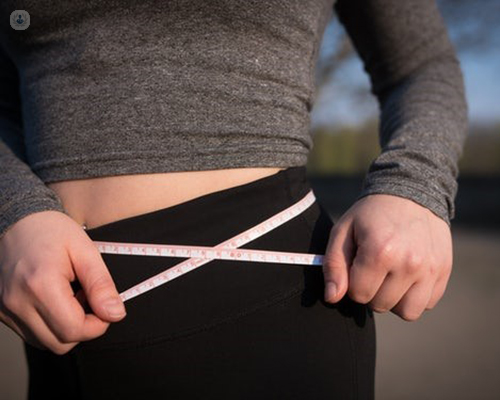What’s the difference between a gastric balloon and a gastric band?
Autore:Weight loss can be a difficult task to accomplish by yourself and eventually some people are left with the choice of opting for a gastric band or gastric balloon to shift the excess weight and to keep the weight off long term. Mr Samer Humadi compares the gastric balloon and gastric band procedures and the advantages and disadvantages of both.
The main difference between a gastric band or a gastric balloon is that all balloon procedures are temporary but, a gastric band can be in place for life.

Types of gastric balloon
There are two types of Orbera gastric balloon, the BIB balloon which stays in the stomach for up to six months and the Orbera 365 balloon which stays in the stomach for up to 12 months. These balloons are inserted endoscopically (through the mouth) when the patient is sedated in theatre. There is no actual surgery involved.
The Elipse intragastric balloon is smaller and inserted in an outpatient environment under X-ray conditions with no sedation. The patient swallows a capsule, the capsule contains the balloon folded very small. The position of the capsule is checked by X-ray before the balloon is inflated with sterile water via a thin tube. The filled balloon is then X-rayed again to check if it’s in the correct position and the tube is removed. The valve on the balloon means that it will self-deflate after four months and the small film covering of the balloon will pass out through the bowel. There is no need for a removal procedure.
The gastric band
Insertion of a gastric band involves surgery in theatre under general anaesthetic. The stomach is not cut but it is a more invasive procedure than the balloon insertions and requires a slightly longer hospital stay to recover from the general anaesthetic.
The band is inserted empty, the patient must wait for the stomach to settle for six weeks and then start to fill the band slowly. If the band is filled too early, there is a high risk of the band slipping which means it could cause pain and will not be effective. It usually takes two or three adjustments to get patients into the “green zone” where they are restricted by the volume they can eat, but they can eat healthy foods.
Some patients make the mistake of having the band too tight, thinking that they will lose more weight but, with that, they are unable to eat the healthy food and all the junk foods they eat can slip right through the band!
The similarities and differences
Both procedures work by reducing the amount of food that someone can eat. They are not right for everyone and depend on a person’s eating habits. The procedures will be less effective if someone gets their excess calories from liquid sources or from snacking on soft foods, as these can slip around the balloon or slip through the band.
Both procedures can be as effective as each other but the gastric balloon is a temporary procedure whereas the gastric band is a long-term procedure. A 5% weight regain can be expected when a gastric balloon is no longer in the stomach.
What about costs?
Gastric banding at the Spire Thames Valley Hospital is offered as a package price of £5,999 which includes the insertion of the band, dietetic support for 12 months after the insertion and four-band adjustments in the first year after the insertion.
The cost of the balloon procedures at the Spire Thames Valley Hospital are as follows:
- The new Elipse “swallow-able” balloon - offered at a package price of £3,950
- The BIB 6 month balloon – offered at a package price of £4,150
- The Orbera 365 balloon – offered at a package price of £4,950
All the balloon procedures are licensed for patients with a BMI of 27 or above. The hospital follows the NICE guidelines, therefore, a patient qualifies for a gastric band if they have a BMI of 35 or above or they have a BMI of 30 or above but suffer from weight-related issues. Please note that eligibility is based on a person’s heaviest BMI, which may be higher than their current BMI.
The advantages of the gastric band
The advantages of a gastric band are that you can control the level of restriction. If you are going on a lovely holiday and want to be able to eat whatever you want, you can have the band loosened. Ladies can also have the band loosened if they fall pregnant and need to ensure the supply of nutrients to the baby. If a person feels that they are putting weight on as they get older, the band can be tightened to get them back down to their target weight.
Disadvantages of the gastric band
However, there a number of disadvantages with the gastric band!
- Firstly, the band can slip and cause pain. It may need to be emptied fully or may need to be removed.
- A band can erode into the stomach and, if this happens, it will need to be surgically removed.
- The patient needs to come back to the consultant for band adjustments.
This is unlike a gastric sleeve procedure which, like the band, reduces the volume of the stomach but is a “one-off” procedure. Fewer gastric bands are inserted currently because the more invasive procedures such as the sleeve gastrectomy and a gastric bypass have much greater lasting benefits. These procedures are, however, irreversible and far more invasive.
The advantages of the gastric balloon
The advantages of gastric balloons are that they are quick to insert and to remove. They are temporary and can be removed at any time.
The disadvantage of all the balloons is that it’s possible to regain weight after the balloon has been removed. The patient needs to work with the dietitian to make diet and lifestyle changes while the balloon is in place, which should be followed when the balloon comes out.
Some people find the larger balloons very difficult to tolerate, so sometimes they have to be removed early. Patients can be very nauseous for the first few days and it takes a while for the balloon to settle.
Regardless of the procedure, every patient must work with a specialist dietitian to achieve the best possible weight loss result that will last long term. Your consultant will offer you the best possible advice regarding the most effective procedure for you, taking into account comorbidities, any medication you’re currently taking, current eating patterns and your weight loss and health goals.
For further information about weight loss procedures please contact Mr Samer Humadi.


